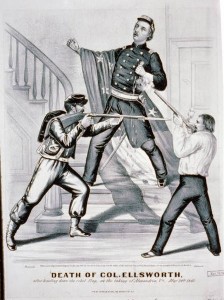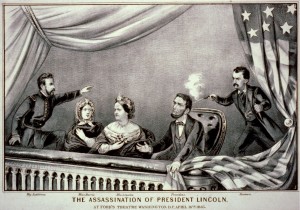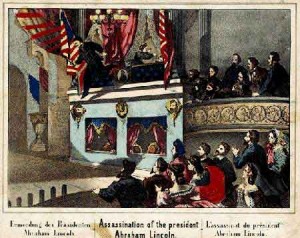How a flag snagged an assassin
The ongoing sesquicentennial of the Civil War is leading, inexorably, to the 150th anniversary of the 1865 assassination of President Abraham Lincoln, who died within days of the surrender of General Robert E. Lee at Appomattox, Virginia.
Flags played a role at both the beginning of the war and in the death of Lincoln. In May 1861, one of his closest friends, Col. Elmer Ellsworth, was dispatched to tear down a Confederate flag that was flying from the rooftop of a hotel in Alexandria, Virginia. Because the flag could be seen from the White House, it was considered especially defiant.

Ellsworth succeeded in bringing down the banner but was killed as he descended a staircase with the flag in his hands. The president ordered that his friend’s body lie in state in the White House.
 Four years later, on April 14, 1865, John Wilkes Booth shot Lincoln in Ford’s Theater. Booth’s escape was hampered as he leapt from the box in which the president sat and caught his spur on a draped flag. Landing clumsily on the stage, Booth broke his fibula. The injury slowed his race southward, and he was later killed by federal troops.
Four years later, on April 14, 1865, John Wilkes Booth shot Lincoln in Ford’s Theater. Booth’s escape was hampered as he leapt from the box in which the president sat and caught his spur on a draped flag. Landing clumsily on the stage, Booth broke his fibula. The injury slowed his race southward, and he was later killed by federal troops.
Dr. Charles Leale, the first physician to reach the dying Lincoln, wrote about being in the theater and hearing the gunshot. “A man of low stature with black hair and eyes was seen leaping to the stage beneath, holding in his hand a drawn dagger,” Leale said. “While descending, his heel got entangled in the American flag, which was hung in front of the box, causing him to stumble when he struck the stage….I then heard cries that the ‘President had been murdered.’”

Some historians have disputed that Booth’s leg was injured in his leap. In his 2004 biography of Booth, “American Brutus,” Michael W. Kaufmann speculates that the assassin’s injury actually occurred during his escape, when “his horse tripped and rolled over on him.”
Sometimes, however, history prefers symmetry, in this case, the symmetry of Ellsworth’s death while tearing down the enemy’s banner and Lincoln’s assassin being tripped up by a flag that represented the reunited nation.
